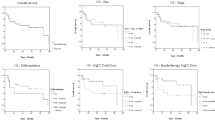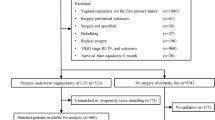Abstract
Background
Vaginal neoplasms are rare. To study the survival of patients depending on tumour characteristics and age, the data from the national cancer registries in Germany were analysed.
Methods
In a retrospective analysis, data from 2006 to 2015 on disease stage, survival, and factors that might affect prognosis were analysed.
Results
Altogether, out of 4004 datasets, 2194 were deemed adequate to be included in the analysis. Overall survival at 5 years (5YSR) and relative survival (5RSR) were 48.6% (95%CI 45.4–52.1%) and 58.7% (95%CI 55.3–61.2%) for carcinomas, but significantly worse at 20.2% (95%CI 8.3–32.0%) and 24.2% (95%CI 16.4–32.0%) for melanomas and 38.3% (95%CI 23.3–53.5%) and 44.4% (95%CI 31.5–56.8%) for sarcomas. 5YSR and 5RSR correlated significantly with FIGO stages (5YSR: 66.9–10.1%; 5RSR: 81.7–11.9%, p = 0.04). Furthermore, survival depended on the absence of LN metastases (5RSR: 59.1% vs. 38.0%, p < 0.001), and the tumour grading had an influence (5RSR: 83.7–52.1%). We also noted that prognosis was worse for older patients ≥75 years (5RSR:51.2%) than for patients <55 years (62.2%) and 55–74 years of age (61.6%).
Conclusion
Unless LN metastases, local advanced tumours and G3 grading are associated with a worse prognosis. Relative survival of older patients decreases, perhaps indicating that treatment compromises have been made



Similar content being viewed by others

Notes
Robert Koch-Institute, Department of Epidemiology and Health Monitoring, German Centre for Cancer Registry Data, Berlin, Germany.
References
Adams TS, Cuello MA (2018) Cancer of the vagina. Int J Gynaecol Obstet 143(Suppl 2):14–21
Alemany L, Saunier M, Tinoco L et al (2014) Large contribution of human papillomavirus in vaginal neoplastic lesions: a worldwide study in 597 samples. Eur J Cancer 50:2846–2854
American Joint Committee on Cancer. Vagina. In: AJCC Cancer Staging Manual, 8th ed. New York, NY: Springer; 2017:641–47.
Bertoli HK, Baandrup L, Aalborg GL, Kjaer AK, Thomsen LT, Kjaer SK (2020) Time trends in the incidence and survival of vaginal squamous cell carcinoma and high-grade vaginal intraepithelial neoplasia in Denmark - a nationwide population-based study. Gynecol Oncol 158:734–739
Bray F, Ferlay J, Soerjomataram I, Siegel RL, Torre LA, Jemal A (2018) Global cancer statistics 2018: GLOBOCAN estimates of incidence and mortality worldwide for 36 cancers in 185 countries. CA Cancer J Clin. 68:394–424 (Erratum in: CA Cancer J Clin. 2020;70:313.)
Cao D, Wu D, Xu Y (2021) Vaginal intraepithelial neoplasia in patients after total hysterectomy. Curr Probl Cancer. 45:100687
Centre for Cancer Registry Data at the Robert Koch Institute: Database query with estimates of the incidence, prevalence and survival of cancer in Germany based on epidemiological state cancer registry data (DOI: https://doi.org/10.18444/5.03.01.0005.0015.0002)
Chyle V, Zagars GK, Wheeler JA, Wharton JT, Delclos L (1996) Definitive radiotherapy for carcinoma of the vagina: outcome and prognostic factors. Int J Radiat Oncol Biol Phys 35:891–905
Daling JR, Madeleine MM, Schwartz SM et al (2002) A population-based study of squamous cell vaginal cancer: HPV and cofactors. Gynecol Oncol 84:263–270
Di Donato V, Bellati F, Fischetti M, Plotti F, Perniola G, Panici PB (2012) Vaginal cancer. Crit Rev Oncol Hematol 81:286–295
Diagnostics, therapy and follow-up care of vaginal cancer and its precursors. Guideline of the DGGG and OEGGG (AWMF 032/42 Oct. 2018 http://www.awmf.org/leitlinien/detail/ll/032-042.html
Ebisch RMF, Rutten DWE, IntHout J et al (2017) Long-lasting increased risk of human papillomavirus-related carcinomas and premalignancies after cervical intraepithelial neoplasia grade 3: a population-based cohort study. J Clin Oncol 35:2542–2550
Ederer F, Astell LM, Cutler SJ (1961) The relative survival rate: a statistical methodology. Natl Cancer Inst Monogr 6:101–121
Geiss K, Meyer M (2013) A Windows application for computing standardized mortality ratios and standardized incidence ratios in cohort studies based on calculation of exact person-years at risk. Comput Methods Programs Biomed. https://doi.org/10.1016/j.cmpb.2013.05.028
Gunderson CC, Nugent EK, Yunker AC et al (2013) Vaginal cancer: the experience from 2 large academic centers during a 15-year period. J Low Genit Tract Dis. 17:409–13
Jentschke M, Hoffmeister V, Soergel P, Hillemanns P (2016) Clinical presentation, treatment and outcome of vaginal intraepithelial neoplasia. Arch Gynecol Obstet 293:415–419
Kucera H, Vavra N (1991) Radiation management of primary carcinoma of the vagina: clinical and histopathological variables associated with survival. Gynecol Oncol 40:12–16
Merino MJ (1991) Vaginal cancer: the role of infectious and environmental factors. Am J Obstet Gynecol 165:1255–1262
Perez CA, Camel HM, Galakatos AE et al (1988) Definitive irradiation in carcinoma of the vagina: long-term evaluation and results. Int J Radiat Oncol Biol Phys 15:1283–1290
Perez CA, Grigsby PW, Garipagaoglu M et al (1999) Factors affecting longterm outcome of irradiation in carcinoma of the vagina. Int J Radiat Oncol Biol Phys 44:37–45
Puri S, Asotra S (2019) Primary vaginal malignant melanoma: a rare entity with review of literature. J Cancer Res Ther 15:1392–1394
Reshko LB, Gaskins JT, Metzinger DS, Todd SL, Eldredge-Hindy HB, Silva SR (2021) The impact of brachytherapy boost and radiotherapy treatment duration on survival in patients with vaginal cancer treated with definitive chemoradiation. Brachytherapy 20:75–84
Siegel RL, Miller KD, Jemal A (2019) Cancer statistics, 2019. CA Cancer J Clin 69:7–34
Sopracordevole F, Barbero M, Clemente N et al (2016) High-grade vaginal intraepithelial neoplasia and risk of progression to vaginal cancer: a multicentre study of the Italian Society of Colposcopy and Cervico-Vaginal Pathology (SICPCV). Eur Rev Med Pharmacol Sci 20:818–824
Tainio K, Jakobsson M, Louvanto K et al (2016) Randomised trial on treatment of vaginal intraepithelial neoplasia-Imiquimod, laser vaporisation and expectant management. Int J Cancer 139:2353–2358
United States Cancer Statistics: Data Visualizations, Centers for Disease Control and Prevention (CDC), https://gis.cdc.gov/Cancer/USCS/DataViz.html Accessed 25 April 2021
Urbański K, Kojs Z, Reinfuss M, Fabisiak W (1996) Primary invasive vaginal carcinoma treated with radiotherapy: analysis of prognostic factors. Gynecol Oncol 60:16–21
Wu X, Matanoski G, Chen VW, Saraiya M, Coughlin SS, King JB, Tao XG et al (2008) Descriptive epidemiology of vaginal cancer incidence and survival by race, ethnicity, and age in the United States. Cancer 113:2873–82
Yagi A, Ueda Y, Kakuda M et al (2017) Descriptive epidemiological study of vaginal cancer using data from the Osaka Japan population-based cancer registry: Long-term analysis from a clinical viewpoint. Medicine 96:e7751
Yang J, Delara R, Magrina J et al (2020) Management and outcomes of primary vaginal cancer. Gynecol Oncol 159:456–463
Funding
Our research received no funding.
Author information
Authors and Affiliations
Corresponding author
Ethics declarations
Conflict of Interest
The author report no conflict of interest.
Ethical Approval
The use of the data for this study was reviewed and approved by the Scientific Board of the German Centre for Cancer Registry Data, Robert Koch Institute.
Additional information
Publisher's Note
Springer Nature remains neutral with regard to jurisdictional claims in published maps and institutional affiliations.
Rights and permissions
About this article
Cite this article
Forner, D. Characteristics and survival of primary vaginal malignancy: an analysis of the German nationwide cancer registry data. J Cancer Res Clin Oncol 149, 1115–1122 (2023). https://doi.org/10.1007/s00432-022-03982-7
Received:
Accepted:
Published:
Issue Date:
DOI: https://doi.org/10.1007/s00432-022-03982-7



